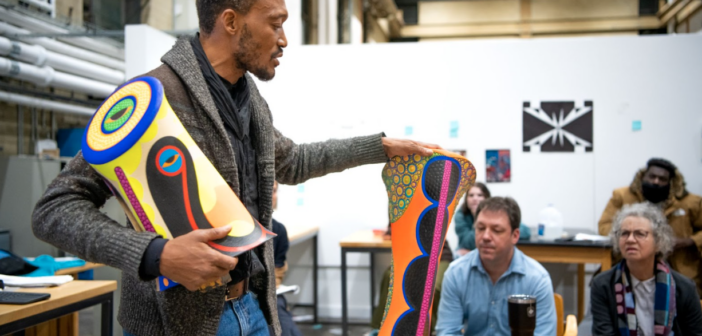Claes Gabriel always knew he was destined to be an artist. Named after the Swedish-American sculptor Claes Oldenburg, Gabriel started painting canvases at three years old on his father’s failed canvases.
Gabriel immigrated from Haiti to the United States in 1989. He is a modernist artist now based in Philadelphia.
“Being from Haiti, you are 50% artist no matter what profession you choose,” Gabriel said.
Adjunct professor Maren Less said Gabriel’s Haitian culture emerges in his art.
Less selected Gabriel to be a visiting artist to speak to an audience at Lehigh in September and October. Less said professors within the art, architecture and design department may invite a guest speaker who can then be open to the public.
Less said visiting artists are meant to “switch up” the department, bringing in an outside voice to hear from.
Less said it is good for Lehigh students to see Gabriel’s trajectory as a professional artist because of the difficulty associated with the career path.
Gabriel said most children are artists, but stop producing work around middle school because of self-doubt.
“To make it as a painter is difficult,” Less said. “So to see somebody’s path, feel inspired, have some new ideas and to listen to somebody with different ideas (helps).”
Gabriel is the son of Jacques Gabriel, a classically trained artist who found fame depicting the reality of Haitian peasant life through modernist work.
“I was a huge fan of my father from the beginning,” Gabriel said. “Everything I know about composition, color, design comes from him.”
He wanted to differentiate his style of work from his father’s defined style of traditional painting tactics. His main artwork forms are three dimensional shape canvases, two dimensional flat canvases and murals.
When making a three dimensional shape canvas, Gabriel said he starts by carving pieces of wood. He then stretches the canvas around it tightly and examines the structure to determine what should be painted.
“His work is extremely time-consuming, slow and thoughtful,” Less said.
Gabriel said as he gets older, he spends more time perfecting his work, valuing quality over quantity.
Gabriel wants most of his work to celebrate female deities or goddesses.
“It’s much harder to do a painting that addresses beauty over political issues,” Gabriel said.
But, he said he does not want his artwork to sell just because it’s controversial. He hopes his work is agreeable with viewers.
When asking for opinions about his artwork, Gabriel said he is critiqued by three groups of people: children, non-artists who know little about art and other artists.
Clare Jachim, ‘24, said she wants to bring some elements of Gabriel’s work, such as colors and shape, into her own.
“He’s so humble,” Jachim said. “His work is very powerful and bold, but then when you talk to him, he’s very chill and nonchalant.”
Emma Camp, ‘24, said her artistic style aligns with Gabriel. She said she learned from Gabriel that simplicity can be the key to a good piece.
“I (had) never heard of (Gabriel) before but … I will actually use things that he showed,” Camp said.
Camp said she is thankful that Gabriel came to inspire the next generation of young artists.






Comment policy
Comments posted to The Brown and White website are reviewed by a moderator before being approved. Incendiary speech or harassing language, including comments targeted at individuals, may be deemed unacceptable and not published. Spam and other soliciting will also be declined.
The Brown and White also reserves the right to not publish entirely anonymous comments.